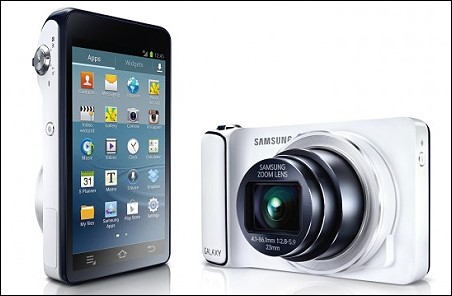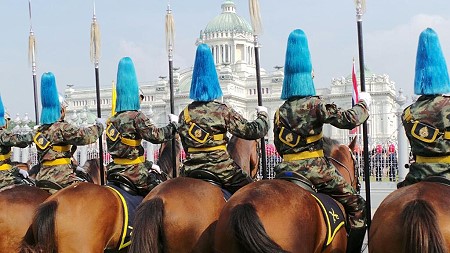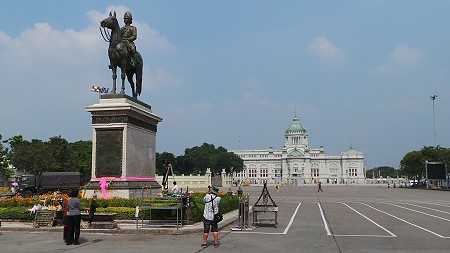First Look at the Samsung Galaxy Camera

As many of you know, I work in social media. I am a full time travel blogger here in Thailand which also involves a lot of tweeting. Both from tourist attractions and events. The tools that I use must be good, fast and reliable. More importantly, they cannot cost an arm and a leg as my company doesn’t have a big budget. When I first heard about the Samsung Galaxy Camera it sounded perfect for me. In a nutshell, it is a cross-between a compact camera and a smartphone operated by Android. It has everything apart from the telephone. The camera was launched at the BITEC Photo Fair this week and I was one of the first in the queue to check it out. The price, at 16,900 Baht ($550), was a little more than what I wanted to pay. I think a figure around 15,000B would have been more attractive. But it seemed to have everything that I need for my social media work. So, I took the plunge and bought my first ever compact camera. Also my first electronic device run by Android.

After charging the camera overnight, I set off this morning to give it a field test. To be fair to Samsung, this was a baptism by fire. I was attending a live event for Trooping the Colour in Bangkok. I hadn’t read the manual and I was literally using it straight out of the box. In addition, I had my regular DSLR camera that I was using to photograph the event. To make it a proper test, I decided that I wouldn’t use my iPhone to live tweet the event. Instead, everything would be done with the camera. To connect to the Internet, I had three choices: WiFi, HotSpot or the MicroSIM from my iPhone. I chose the latter. As it is an Android device, I downloaded some aps that I would need. For example, Twitter and Facebook, iLoader for uploading to Facebook, Photo Collage for pictures like the above, and WordPress to do live blogs. The first big test was at The Marble Temple where I parked my car. This picture clearly shows what sold the camera for me. The x20 optical zoom is impressive. Both of the pictures above were taken from the same spot and then tweeted live.

The camera is obviously bigger and heavier than my iPhone, but as there are no dials on the back (it is touchscreen), it easily slipped into my pocket. I was also just about able to hold it in my hand while taking pictures with my big DSLR. In all, I took about 180 pictures on the compact camera and 600 on the DSLR. I was able to upload highlights to Facebook and also to Twitter. There was also an option to upload automatically to an album on Google+ and also to Dropbox which I didn’t do. As it is a normal Android device, there are photo editors that you can use. However, the only one that I downloaded was for doing collages. The camera itself also has many options for taking pictures, everything from shutter speed to ISO, but I left it on automatic in interest of speed. In this test, I was using my True 3G H MicroSIM card. I didn’t experience any problems with uploading to either Facebook or Twitter. All seemed fast without a hitch. When I bought the camera they gave me a free AIS SIM card that had 50MB which lasts 3 months. At this moment I am not sure what I will do about SIM cards.

As someone who is into social media, I love this compact camera. However, I won’t be ditching my DSLR anytime soon. Nor will I throw away my iPhone. It is a great camera but there are a few problem areas. Firstly, the operating system crashed twice. The lens was stuck open and I couldn’t close it. At the time I was trying to get to the photo album to tweet a picture. Once I figured how to restart the device it didn’t take too long to get it up and running again. Secondly, compared to the iPhone, the camera is a bit slow in taking pictures and so I sometimes missed the next shot. It was also a bit slow in focussing sometimes. Thirdly, and the biggest minus of all, the battery life sucks. I think I read it would last only six hours. I started using the camera at about 7:30 a.m. I think it was nearly 11 a.m. when a message popped up to say that the battery was running low. I am not familiar with it enough to know how much longer I could have used it. I am sure there are ways that I could cut down on battery usage. For a start, there was no real need for me to have Facebook notifications. And there was also emails coming in during the morning.

When I came back and saw the quality of the pictures that I had tweeted, I must say that I was impressed. The iPhone 4S can take good pictures but it is not consistent in every situation. The Samsung seems to be better so far. Though obviously I haven’t used it yet in low light and for food pictures. I will continue this test during this week. I need to get used to both the camera and Android. I think some of the problems today can be overcome. The battery pack I use with my iPhone can be used with the Samsung camera. The battery can also be taken out (same battery as Samsung II). Like my DSLR, maybe I should buy a second battery. I am keen to use the Samsung Galaxy Camera again for live events. Mainly because of the zoom and the picture quality. For this I will probably borrow my MicroSIM from the iPhone. I cannot see myself buying a separate data package. Not yet anyway. For general everyday pictures, I will probably stick with the iPhone. After all, its slimmer and something that I carry around with me all the time. I don’t think I will be doing that with the Samsung camera.

These are just some notes on the first day of using the camera. Obviously I will write more later once I get used to all of the features. I will also do some comparison pictures between the Samsung camera and the iPhone. Feel free to ask questions and I will try and answer [Some pictures from today].


Could you test if you can receive calls on the device. I know that some specifications say that it’s not possible, but sometimes there are different country variants which might allow that.
I’m looking for an replacement for both phone and camera.
It’s not a phone so you cannot receive calls in the normal way. But I guess you can do skype calls.
Yes, I’ve being rueing the fact that my Sony 5N can’t instantly transfer images to the web, even for social networking – would there be a USB device available ever. Richard, ensure that all push notifications etc are turned off to preserve battery life. Sounds handy all the same, take all the pro shots with the DSLR and snap a few ‘on the spots’ with the Samsung. iPhone camera really isn’t good enough for professional media I find, the f-stop makes it far to slow in dim light.
interesting, as always, comments and review.
it would help to know what apps were running in the background?
What modes were you shooting in?
Please define crash, locked, shut down?
what size pictures were you storing/uploading?
With android using a CPU monitor helps learn what to shut down.
When you say slow in taking the shot, do you mean “button lag”?
I hope mine arrives this week, but find your comments useful
Thx
Tom
I am not experienced with Android yet and so cannot tell you what was running in the background. This is just a first look review under intense conditions. I will write more reviews later this week. I was shooting in full automatic as I didn’t have the time or knowledge to change any setting for taking pictures. Crashed meant the lens was out but I couldn’t do anything. The last picture was frozen on the screen. For pictures I was taking highest quality. I uploaded to twitter via the photo album which I believe resized automatically. When I say slow in taking shots, this was both trying to focus and also after I took a picture and was waiting to take the next. This might be partly due to the fact I am also not experienced with compact camera limitations. Maybe nothing to do with this camera. I think some of these things will become minor limitations once I get used to it. I do intend to use it again to live tweet events.
Richard, are you happy with True 3G data coverage? We are trying you decide on a carrier for our trip this month.
Yes, it is getting better all the time. Last year I could barely get Edge in Ayutthaya but now 3G is widespread there. Looking at the coverage map for 3G, True is the most comprehensive. But for islands and the outer reaches of Thailand, AIS is better as True’s signal sometimes drops out.
Why don’t you create a wifi hotspot with your Iphone (tethering) and connect the camera to the iphone via wifi? No need to have two SIM cards…but wifi might drain more bat?
I was thinking of doing that originally. Before I bought the camera, I double checked that this was possible. However, with the WiFi hotspot, I was worried that the connection would drop out if I wasn’t using it all the time on the camera and that I would have to take the time and trouble to reconnect. I was at a live event and didn’t want the bother of this. So, I just switched my SIM from my iPhone to the Samsung camera. I will test tethering at another time.
Secondly, as you mentioned, tethering would have been a drain on the battery on my iPhone. At the back of my mind I was thinking that if the battery on the camera went dead then I would switch back to my iPhone which should still be fully charged.